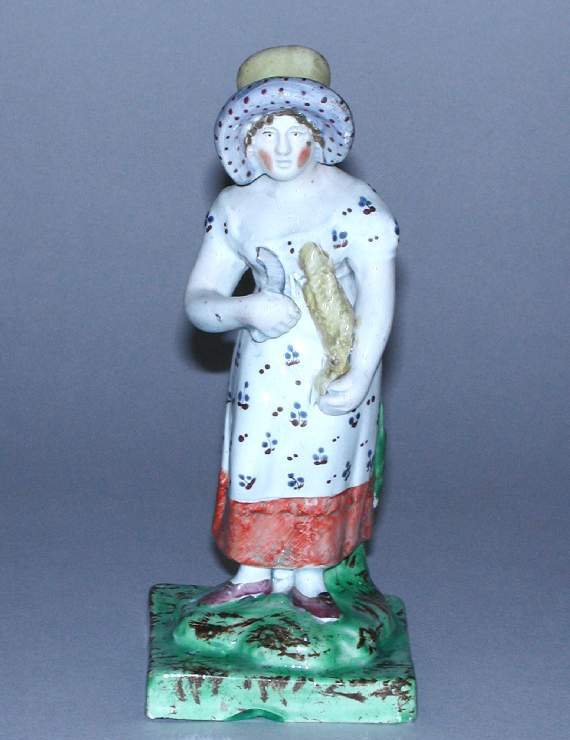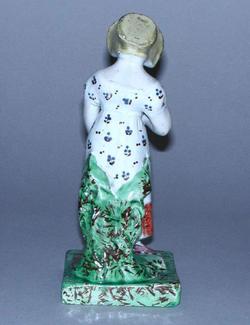Current Location: In storage
Titles
Summer
Maker(s)
Production:
Unidentified factory
John Walton
(Possibly)
Entities
Categories
Description
Earthenware figure, moulded and modelled, pearlware glazed and painted with polychrome enamels.
White earthenware figure of a woman holding a sheaf of corn in her left hand and a sickle in her right. Her yellow poke bonnet is lined with brown spots on a mauve ground, and her curls show at the front. She wears a white dress with a red-brown and blue sprig pattern over an orange petticoat and brown shoes. She stands on a green mound against a green bush, both streaked with brown, set on a low square base of the same colours. The underside is recessed and glazed, with an off-centre vent hole. The glaze is tinged blue.
Notes
History note: Bought from Mr F.J. Morrell, 48 Liverpool Road, Stoke-upon-Trent, on 24 October 1911, for £1. 5s (one pound five shillings), by Dr J.W.L. Glaisher, Trinity College, Cambridge.
Legal notes
Dr. J.W.L. Glaisher Bequest, 1928
Measurements and weight
Height: 16.2 cm
Width: 6.5 cm
Acquisition and important dates
Method of acquisition: Bequeathed
(1928)
by
Glaisher, J. W. L., Dr
Dating
19th Century, Early
Production date:
circa
AD 1810
Note
Pearlware figures decorated with enamels were in production by 1780. They were generally made at smaller potteries and are rarely marked. A cheaper alternative to porcelain figures, they drew on a variety of 3-D sources, including sculpture and porcelain figures. Classical, biblical, mythological and literary subjects were popular, as were animals and representations of rural life, seasons and trades. From the early 19th Century, potters turned also to more original scenes from everyday life and topical events. Bodies are moulded, often with moulded or modelled parts added and bases formed separately. However, these early methods were relatively costly and by c.1835 they had largely given way to three-part press-moulding, allowing mass production of figures for a growing market.
Personification of the seasons were well known from Classical times, with summer often represented as a young woman holding a sickle and ears of corn. Staffordshire potters varied this traditional theme by modelling everyday rural men and women.
People, subjects and objects depicted
Components of the work
Decoration
composed of
lead-glaze
( blue tinged)
enamels
Parts
Materials used in production
Earthenware
Techniques used in production
Moulding
: Earthenware, moulded and modelled, lead glazed and painted with polychrome enamels.
Inscription or legends present
- Text: No 3510. Staffordshire statuette of Autumn b. at Stoke on Trent Sept 12. 1911.
- Location: Underside of base
- Method of creation: Rectangular label handwritten in black ink
- Type: Label
References and bibliographic entries
Identification numbers
Accession number: C.948-1928
Primary reference Number: 76429
Old object number: 3510
Stable URI
Audit data
Created: Saturday 6 August 2011
Updated: Monday 25 March 2024
Last processed: Tuesday 15 July 2025
Associated departments & institutions
Owner or interested party:
The Fitzwilliam Museum
Associated department:
Applied Arts





